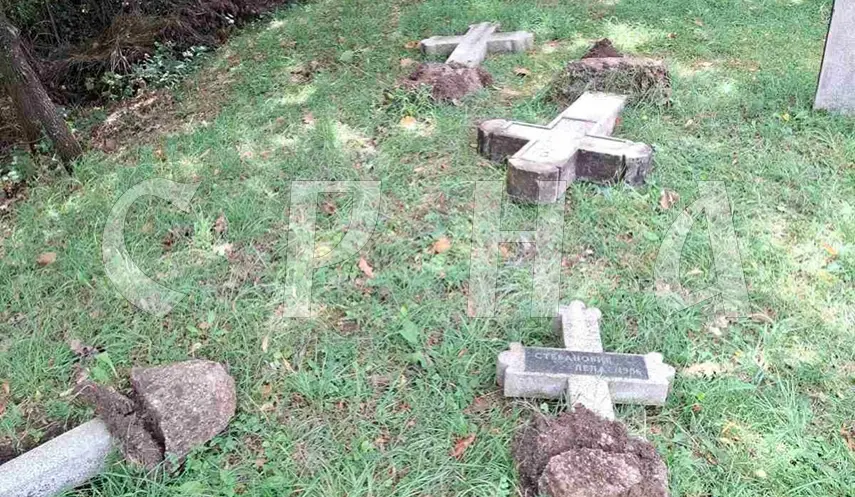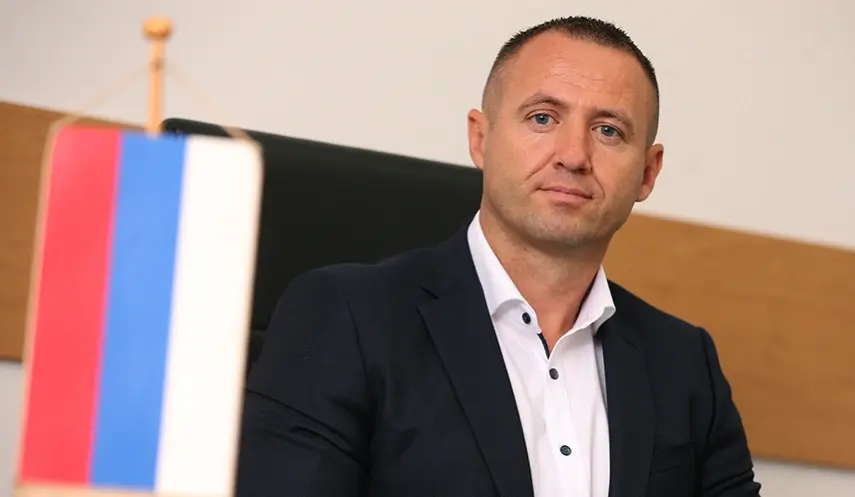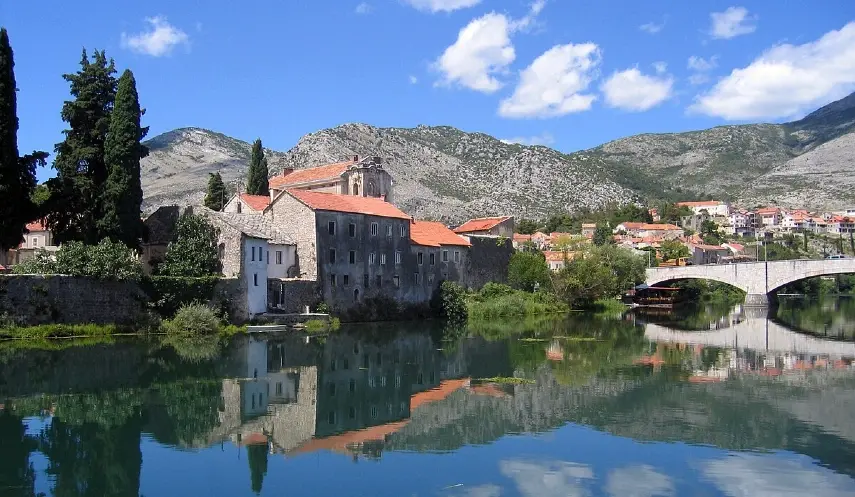BY DEMOLISHING AND LOOTING, THEY ARE ERASING TRACES OF SERB PRESENCE IN FBiH
FBiH - Serbs
09/16/2025
11:19

ISTOČNO SARAJEVO, SEPTEMBER 16 /SRNA/ – This year, 72 attacks have been recorded in the Federation of BiH /FBiH/ targeting Serb property and assets belonging to the Serbian Orthodox Church, with the latest act of vandalism being the destruction of tombstones at the Orthodox cemetery in the village of Pečuj near Zenica, which had withstood Ottoman and Austro-Hungarian occupation, but not the harsh reality of today's FBiH, which sends a dangerous message to both the expelled and remaining Serbs.
Following the expulsion of nearly half a million Serbs from today's FBiH, Serb cemeteries are now being desecrated, churches and private property looted - indicating that the persecution continues, nearly three decades after the signing of the Dayton Peace Accords
Regarding the desecration of Orthodox graves in Pečuj, investigations have yet to identify the perpetrators who smashed crosses - some of which are over 150 years old, clearly marking centuries of Serb presence in the area.
Despite many promises of assistance, restoration of the destroyed tombstones has not yet begun. The few remaining Serbs in Zenica, along with the clergy of the Serbian Orthodox Church /SOC/, are left asking: What is the goal, if even the dead are not allowed to rest in peace?
The destroyed tombstones near Zenica represent what some call the final stage of erasing Serb traces from this region.
In total, 60 tombstones were desecrated in Pečuj, some dating back to the mid-19th century — surviving previous occupations, but not the modern-day FBiH.
From almost 30,000 Serbs pre-war, today Zenica has no more than 600 Orthodox residents. The rest have left or sold their property. Only graves remain as testimony of Serbs in the Bosna River Valley — and even those traces are now being wiped out.
In a similar act, vandals desecrated the Orthodox cemetery Mošćanica near Zenica in 2017. In Kakanj, graveyard chapels are frequently targeted; a church in Tuzla was looted; in Mostar, vehicles belonging to Serb returnees were torched.
"There are no arrests, no detailed police or prosecutorial investigations, and no court rulings for these disturbingly frequent acts of vandalism. There is no political will to stop this. Only where there is a Serb soldier, Serb police, Serb state - there are Serbs safe from attacks on themselves and their property, churches, and cemeteries. Our only safe haven is Republika Srpska," said Đorđe Radanović, president of the Committee for the Protection of Serbs in FBiH.
Radanović condemned the incidents as despicable acts and said he could not understand the level of hatred toward Orthodoxy and the Serb people.
According to him, Orthodox cemeteries are also being vandalized in other FBiH municipalities such as Maglaj, Kakanj, Zavidovići, and Breza.
"Everything that is Serbian and Orthodox is under attack in the Federation of BiH. This is not politics or exaggeration. 675 military apartments that belonged to Serbs who served in the JNA were confiscated," Radanović pointed out.
He emphasized that Serbs are not employed in FBiH government institutions and that, although Cyrillic is formally recognized in schools, it is not actually taught.
"Most Cyrillic road signs have been crossed out or sprayed over. The Catholic Church and Islamic Community receive massive state funding, while the Serbian Orthodox Church receives only symbolic support," Radanović added.
TARGETING EVERYTHING IN CYRILLIC
Radanović also noted that SOC properties in Sarajevo such as the building of the Theological Seminary, currently used by the Faculty of Economics, have not been returned.
"People are attacked for wearing T-shirts with Cyrillic letters. On New Year's, the tires of four cars with Serbian license plates /Belgrade, Novi Sad, Valjevo/ were slashed in the center of Sarajevo. Serbs' forests are being cut down... There are countless examples of attacks on Serbian symbols and everything that reminds one that Serbs once lived in FBiH — and are now disappearing daily," said Radanović.
Pointing to the extremely difficult position of Serbs in FBiH, the Committee for the Protection of Serbs has sent open letters to ambassadors of Dayton Agreement signatory states, but these have largely been met with silence.
According to the Committee, 542,879 Serbs lived in FBiH in 1991, while the 2013 census registered only 56,550. Serbs once made up the majority in 32.2% of today's FBiH territory, in 785 settlements, and today, they are almost gone.
Goran Broćeta, Serb delegate in the House of Peoples of the FBiH Parliament, stated that the position of Serbs in FBiH, 30 years after the war, remains stuck in the 1990s.
"The desecration of tombstones in Zenica proves that. We’ve seen this pattern since the war, and it hasn't changed. We also see that the constitutional provisions guaranteeing Serbs' constituent status are largely ignored, while some cantons haven't even taken the first steps," Broćeta told SRNA.
DAVID VS. GOLIATH STRUGGLE
Broćeta added that even the Constitutional Court has issued rulings against unconstitutional practices that discriminate against Serbs, but those decisions remain in drawers.
"A clear example is the ruling after the formation of the Posavina Canton Government. There are countless similar cases across FBiH," said Broćeta.
"We keep raising these issues, but authorities and the international community remain unresponsive. Only in Canton 10 /Livanjski Canton/ are constitutional provisions for Serbs partially respected. In other cantons, Serbs are guaranteed only the right to disappear. As we wait for a distant sunny morning, we continue our David vs. Goliath fight," Broćeta said.
ERASING SERBIAN IDENTITY
Dušan Šehovac, president of the Truth and Justice Association, said that global and local forces hostile to the Serbs are targeting Serbian identity wherever Serbs live.
"Everything that can be renamed is renamed, appropriated, looted, desecrated, and destroyed - especially cultural, historical, and spiritual heritage, particularly in areas where Serbs have no political power. The Serbian Orthodox Church and its holy sites - churches, chapels, and cemeteries - are under attack, despite being undeniable evidence of centuries of Serbian presence," Šehovac stated.
He noted that in the area of today’s Sarajevo Canton - once composed of nine municipalities — Orthodox Serbs were the majority until the 1970s.
"Our organization has discovered that this area today contains nine churches, dozens of parish houses and chapels, and about 150 Orthodox cemeteries, many of which have been damaged or looted both during and after the war," Šehovac stated.
He emphasized that cemeteries are sacred cultural spaces for all communities, and that grave markers are not only expressions of religious tradition and remembrance, but also have enormous historical and cultural value.
"Tombstones are like pages from a stone book - they carry the names, stories, and legacies of individuals, families, and peoples. They are historical witnesses to the life of villages, cities, and nations, left behind as proof of identity and presence. By destroying them, our enemies aim to erase all evidence of our existence in FBiH, from which around 500,000 Serbs left - mostly under pressure, and not voluntarily," Šehovac pointed out.

VELJANOVSKI: RECORD REVENUE OF OVER BAM 170 MILLION

HAPPY NEW YEAR!

LAST DAY OF THE YEAR MARKED BY LIFE-SAVING OPERATIONS: AIR TRANSPORT OF A PATIENT FROM NEVESINJE TO BANJALUKA



